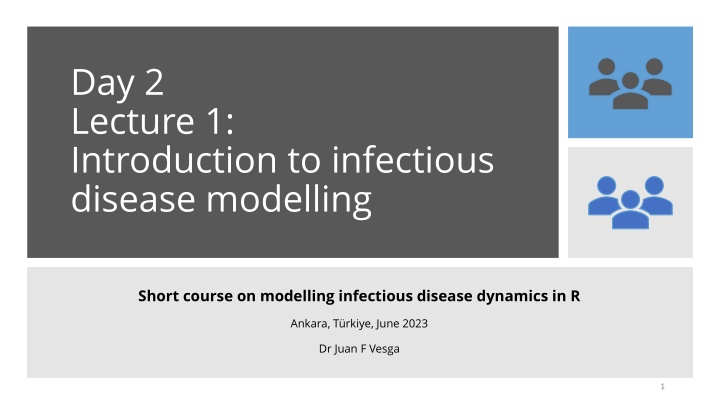
Infectious Disease Modeling Concepts
Dive into the foundations of infectious disease modeling with Dr. Juan F. Vesga in this short course held in Ankara, Turkey. Explore the key aims, principles, and types of models used in understanding infectious diseases, emphasizing the multidisciplinary nature of this field.
Download Presentation

Please find below an Image/Link to download the presentation.
The content on the website is provided AS IS for your information and personal use only. It may not be sold, licensed, or shared on other websites without obtaining consent from the author. If you encounter any issues during the download, it is possible that the publisher has removed the file from their server.
You are allowed to download the files provided on this website for personal or commercial use, subject to the condition that they are used lawfully. All files are the property of their respective owners.
The content on the website is provided AS IS for your information and personal use only. It may not be sold, licensed, or shared on other websites without obtaining consent from the author.
E N D
Presentation Transcript
Day 2 Lecture 1: Introduction to infectious disease modelling Short course on modelling infectious disease dynamics in R Ankara, T rkiye, June 2023 Dr Juan F Vesga 1
Aims of the session To Understand what do we mean by infectious disease models Introduced core concepts of infectious diseases dynamics Familiarize with existing types of ID models 2
[Widely repeated quote goes here ] and it is true! 3
What are models Some models intend to infer conclusions as we accrue more data Most statistical models -> the model emerges from the data ! Some models intend to describe a mechanism behind a phenomenon Mathematical models Used for example in weather, physics, engineering, ecology, and infectious diseases! 4
We need to understand the phenomenon Weather: very predictable -> laws of physics Infectious diseases -> very complex! Biology of the pathogen Clinical characteristics Host behaviour Population dynamics By definition a multidisciplinary field (all are welcome!) 5
So how does an ID model looks like? For most people Danger! complicated stuff inside Data of all shapes and colours ! Shiny model output Let s unpack this black box (in three days!) 6
So how does an ID model looks like? How it really looks A dynamic component! Ia ? ? S Is 1 ? Carefully selected data to fuel our mechanism A model projection A design of our phenomenon described with maths 7
What type of data inputs? Let s imagine a cohort where infected individuals become symptomatic Given we understand the mechanism we want to describe: ? Infected Symptomatic Model inputs are the pieces of information (facts) that bind together our model design. We need statistics to interpret these binding links. 1 ? = ???? ?????????? ?????? 1 ? = 12 ???? 8
What do we need to design a mathematical model? Some maths For compartmental models we use ordinary differential equations (ODEs) Some statistics : for summarising model inputs and for processing model results 9
Ordinary differential equations (ODEs) Mathematics used to describe change of a system, e.g: speed (distance/time) : Change in distance ?? ??= 70 ?? Change in time At a steady speed of 70mph how far can we get in 2 hours? Solve : ? 2 = 70 ? 2 = 140 ????? We will review this further applied to infectious diseases! 10
What about compartments? The previous example requires one single function We are interested in ODE systems with more than one state ?? ??= ? ? ? ? Infected Symptomatic ?? ??= ? ? ? It is clear that this system describes the average behaviour for such phenomenon 11
How we produce model output ? Back to our previous system ?? ??= ? ? ? Numerical integration using a software , R ! ?? ??= ? ? ? 12
What is the output? Is the integration of our system over a time period We projectthe value of our state variables (I and Sy) over 60 days We don t predict since our results come from a simplified systems and assumptions Prediction is for statistics! 13
What about uncertainty in our results? Ia ? ? S Is 1 ? Uncertainty in the inputs Uncertainty in the system Results in uncertainty around our projections We can explore this range by calibrating our parameters If we introduce stochasticity 14
Types of mathematical models Deterministic A same set of model parameters will always produce the same results The results are strictly determined by the parameter values given a system E.g., an infected individual will always develop symptoms at an average rate ?. We will focus on these !! Stochastic A same set of model parameters canproduce different results The results combine the input and randomness in the events of transition E.g., an infected individual can or cannot develop symptoms out of chance. 15
Types of mathematical models Compartmental Describe the system of interest at the population level Are good to understand the average behaviour of a phenomenon Easier to interpret Sometimes hard to code! Individual Simulate individuals Easier to code Harder to interpret Computationally expensive Require much more data 16
Focus in this short course We are interested in public health, not in maths! We want to apply mathematics and statistics to understand infectious diseases These methods have a strong role in the current landscape of public health and can help improve global health! 17
Roles of transmission models in public health Supporting healthcare delivery Basic science: contributing to evidence base for policy 18
What we should know by now What is a mathematical model What are the building blocks of models What are the basic maths for describing a model What types of mathematical models there are How can models contribute to public health 19

